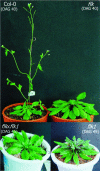A new Arabidopsis gene, FLK, encodes an RNA binding protein with K homology motifs and regulates flowering time via FLOWERING LOCUS C
- PMID: 14973162
- PMCID: PMC385284
- DOI: 10.1105/tpc.019331
A new Arabidopsis gene, FLK, encodes an RNA binding protein with K homology motifs and regulates flowering time via FLOWERING LOCUS C
Abstract
Posttranscriptional RNA metabolism plays versatile roles in the regulation of gene expression during eukaryotic growth and development. It is mediated by a group of RNA binding proteins with distinct conserved motifs. In this study, an Arabidopsis (Arabidopsis thaliana) gene, designated FLK, was identified and shown to encode a putative RNA binding protein with K homology motifs. A mutant in which FLK was inactivated by T-DNA insertion exhibited a severe late flowering phenotype both in long and short days. The late flowering phenotype was reversed by gibberellin and vernalization treatments. The FLOWERING LOCUS C (FLC) transcription was greatly upregulated, whereas those of FLOWERING LOCUS T and SUPPRESSOR OF OVEREXPRESSION OF CONSTANS1 decreased in the mutant. These observations demonstrate that FLK regulates the autonomous flowering pathway via FLC. It is now evident that a battery of different RNA binding proteins are involved in the posttranscriptional regulation of flowering time in Arabidopsis.
Figures








Similar articles
-
Antagonistic interactions between Arabidopsis K-homology domain genes uncover PEPPER as a positive regulator of the central floral repressor FLOWERING LOCUS C.Dev Biol. 2009 Sep 15;333(2):251-62. doi: 10.1016/j.ydbio.2009.06.035. Epub 2009 Jul 2. Dev Biol. 2009. PMID: 19576878
-
Regulation of flowering time by histone acetylation in Arabidopsis.Science. 2003 Dec 5;302(5651):1751-4. doi: 10.1126/science.1091109. Epub 2003 Oct 30. Science. 2003. PMID: 14593187
-
SUPPRESSOR OF FRIGIDA3 encodes a nuclear ACTIN-RELATED PROTEIN6 required for floral repression in Arabidopsis.Plant Cell. 2005 Oct;17(10):2647-60. doi: 10.1105/tpc.105.035485. Epub 2005 Sep 9. Plant Cell. 2005. PMID: 16155178 Free PMC article.
-
Regulated RNA processing in the control of Arabidopsis flowering.Int J Dev Biol. 2005;49(5-6):773-80. doi: 10.1387/ijdb.051995vq. Int J Dev Biol. 2005. PMID: 16096981 Review.
-
Chromatin regulation of flowering.Trends Plant Sci. 2012 Sep;17(9):556-62. doi: 10.1016/j.tplants.2012.05.001. Epub 2012 Jun 2. Trends Plant Sci. 2012. PMID: 22658650 Review.
Cited by
-
Screening of Key Proteins Affecting Floral Initiation of Saffron Under Cold Stress Using iTRAQ-Based Proteomics.Front Plant Sci. 2021 May 11;12:644934. doi: 10.3389/fpls.2021.644934. eCollection 2021. Front Plant Sci. 2021. PMID: 34046047 Free PMC article.
-
A putative CCAAT-binding transcription factor is a regulator of flowering timing in Arabidopsis.Plant Physiol. 2007 Sep;145(1):98-105. doi: 10.1104/pp.107.102079. Epub 2007 Jul 13. Plant Physiol. 2007. PMID: 17631525 Free PMC article.
-
The flowering time regulator FLK controls pathogen defense in Arabidopsis thaliana.Plant Physiol. 2023 Apr 3;191(4):2461-2474. doi: 10.1093/plphys/kiad021. Plant Physiol. 2023. PMID: 36662556 Free PMC article.
-
Comparative physiological and metabolomic analyses reveal natural variations of tulip in response to storage temperatures.Planta. 2019 May;249(5):1379-1390. doi: 10.1007/s00425-018-03072-4. Planta. 2019. PMID: 30671621
-
FVE, an Arabidopsis homologue of the retinoblastoma-associated protein that regulates flowering time and cold response, binds to chromatin as a large multiprotein complex.Mol Cells. 2011 Sep;32(3):227-34. doi: 10.1007/s10059-011-1022-6. Epub 2011 Jun 23. Mol Cells. 2011. PMID: 21710206 Free PMC article.
References
-
- Adinolfi, S., Bagni, C., Morelli, M.A.C., Musco, G., and Pastore, A. (1999). Novel RNA-binding motif: The KH module. Biopolymers 51, 153–164. - PubMed
-
- Amasino, R.M. (2003). Flowering time: A pathway that begins at the 3′ end. Curr. Biol. 13, R670–R672. - PubMed
-
- Bevilacqua, A., Ceriani, M.C., Capaccioli, S., and Nicolin, A. (2003). Post-transcriptional regulation of gene expression by degradation of messenger RNAs. J. Cell. Physiol. 195, 356–372. - PubMed
-
- Blázquez, M.A., Ahn, J.H., and Weigel, D. (2003). A thermosensory pathway controlling flowering time in Arabidopsis thaliana. Natl. Genet. 33, 168–171. - PubMed
Publication types
MeSH terms
Substances
LinkOut - more resources
Full Text Sources
Other Literature Sources
Molecular Biology Databases
Research Materials

